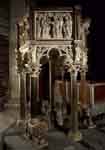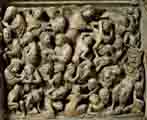 Information on Nicola Pisano is available only from 1220.
Information on Nicola Pisano is available only from 1220.
He studied in the court of Federick and wasvery interested in the classical world.
In 1260 he executed the pulpit of the Baptistry of Pisa. It is hexagonal and supported by six red granite columns; three of them have lions and the base of the central column is decorated with carvings of men and animals. The columns’ capitals are decorated with carvings and are the base of three lobed round arches separated by statues of Prophets and Virtues. Above these arches there are five marble plates which make up the sides of the pulpit’s parapet. On them there are paintings depicting the Nativity, the Adoration of the Magi, the Presentation at the temple, the Crucifixion and the Last Judgement.
There are many classical elements, including the style.
Between 1265 and 1268 Nicola Pisano was in Siena and worked on pulpit of the cathedral with his son Giovanni and Arnolfo di Cambio.
 The pulpit is octagonal and its columns have lions at their base. Three-lobed arches are above the pulpit. The seven plates of the parapet depict stories ofChrist: the Nativity, Adoration of the Magi, the Presentation at the temple, Massacre of the innocents; the Crucifixion and the Last Judgement are two plates joined by Christ the judge.
The pulpit is octagonal and its columns have lions at their base. Three-lobed arches are above the pulpit. The seven plates of the parapet depict stories ofChrist: the Nativity, Adoration of the Magi, the Presentation at the temple, Massacre of the innocents; the Crucifixion and the Last Judgement are two plates joined by Christ the judge.
In this work the artist’s interest in French gothic style is clear: the number of characters increases and figures are lighter, more expressive and more realistic.
In 1278 he and his son Giovanni worked on the monumental fountain in the square in front of Perugia’s Town Hall. There are two polygonal overlapping pools; at the centre is a bronze cup with three carved nymphs on it. The lower pool is decorated with allegorical cycles of the months and the liberal arts, executed using the ‘stiacciato’ technique.